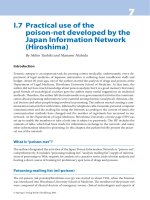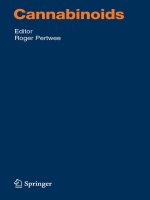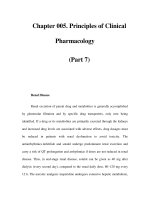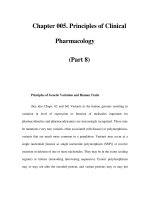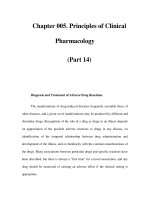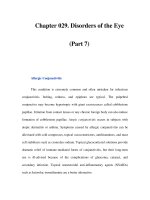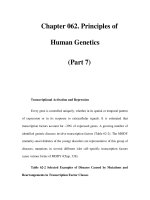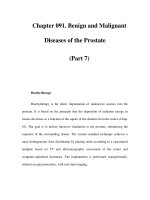Handbook of Experimental Pharmacology - Part 7 pot
Bạn đang xem bản rút gọn của tài liệu. Xem và tải ngay bản đầy đủ của tài liệu tại đây (295.33 KB, 18 trang )
CaMKII in Cardiac Disease 213
References
American Heart Association (2004) Heart disease and stroke statistics—2004 update. Amer-
ican H eart Association
Anderson ME, Braun AP, Schulman H, Premack BA (1994) Multifunctional Ca
2+
/calmo-
dulin-dependent protein kinase mediates Ca
2+
-induced enhancement of the L-type Ca
2+
current in rabbit ventricular myocytes. Circ Res 75:854–861
Anderson ME, Braun AP, Wu Y, Lu T, Schulman H, Sung RJ (1998) KN-93, an inhibitor
of multifunctional Ca
2+
/calmodulin-dependent protein kinase, decreases early after
depolarizations in rabbit heart. J Pharmacol Exp Ther 287:996–1006
Aronows kiJ, Gro ttaJC,WaxhamMN(1992)Ischemia-induced translocation ofCa
2+
/calmo-
dulin-dependent protein kinase II: potential role in neuronal damage. J Neurochem
58:1743–1753
Barrett PQ, Lu HK, Colbran R, Czernik A, Pancrazio JJ (2000) Stimulation of unitary T-type
Ca
2+
channel currents by calmodulin-dependent protein kinase II. Am J Physiol Cell
Physiol 279:C1694–1703
Bassani JW, Bassani RA, Bers DM (1994) Relaxation in rabbit and rat cardiac cells: species-
dependen t differences in cellular mechanisms. J Physiol (Lond) 476:279–293
Bennett MK, Erondu NE, Kennedy MB (1983) Purification and characterization of a cal-
modulin-dependent protein kinase that is highly concentrated in brain. J Biol Chem
258:12735–12744
Bers DM (2001) Excitation-contraction coupling and cardiac contractile for ce. Kluwer Aca-
demic Publishers, Dordrecht
Bilezikjian LM, Kranias EG, Potter JD, Schwartz A (1981) Studies on phosphorylation of
canine cardiac sarcoplasmic reticulum by calmodulin-dependent pro tein kinase. Circ
Res 49:1356–1362
Bliss TV, Collingridge GL (1993) A synaptic model of memory: long-term potentiation in
the hippocampus. Nature 361:31–39
Boknik P,Heinroth-Hoffmann I,KirchheferU,KnappJ,LinckB, Luss H,Muller T,Schmitz W,
Brodde O, Neumann J (2001) Enhanced protein phosphorylation in hypertensive hyper-
trophy. Cardiovasc Res 51:717–728
Bowditch HP (1992) On the peculiarities of excitability which the fibres of cardiac mus-
cle show. In: Noble MIM, Seed WA (eds) The interval-force relationship of the heart:
Bowditch revisited. Cambridge University Press, Cambridge, UK, pp 3–30
Braun AP, Schulman H ( 1995) The multifunctional calcium/calmodulin-dependent protein
kinase: from form to function. Annu Rev Physiol 57:417–445
Ch’en FF, Vaughan-Jones RD, Clarke K, Noble D (1998) Modelling myocardial ischaemia
and reperfusion. Prog Biophys Mol Biol 69:515–538
Cho YH, Giese KP, Tanila H, Silva AJ, Eichenbaum H (1998) Abnormal hippocampal spatial
representations in
αCaMKIIT286A and CREB
α∆−
mice. Science 279:867–869
Churn SB, Taft WC, Billingsley MS, Sankaran B, DeLorenzo RJ (1992) Global forebrain
ischemia induces a posttranslational modification of multifunctional calcium- and
calmodulin-dependent kinase II. J Neurochem 59:1221–1232
Clancy CE, Rudy Y (1999) Linking a genetic defect to its cellular phenotype in a cardiac
arrhythmia. Nature 400:566–569
Colomer JM, Mao L, Rockman HA, Means AR (2003) Pressure overload selectively up-
regulates Ca
2+
/calmodulin-dependent protein kinase II in vivo. Mol Endocrinol
17:183–192
Coomber CJ (1998) Site-selective autophosphorylation of Ca
2+
/calmodulin-dependent pro-
tein kinase II as a synaptic encoding mechanism. Neural Comput 10:1653–1678
214 T.J. Hund · Y. Rudy
Currie S, Smith GL (1999a) Calcium/calmod ulin-dependent protein kinase II activity is
increased in sarcoplasmic reticul um from coronary artery ligated rabbit hearts. FEBS
Lett 459:244–248
Currie S, Smith GL (1999b) Enhanced phosphorylation of phospholamban and down-
regulation of sarco/endoplasmic reticulum Ca
2+
ATPase type 2 (SERCA 2) in cardiac
sarcoplasmic reticulum from rabbits with heart failure. Cardiovasc Res 41:135–146
Currie S, LoughreyCM, Craig MA, Smith GL (2004) Calcium/calmodulin-dependent protein
kinaseII
δ associateswiththe ryanodine receptorcomplexandregulateschannelfunction
in rabbit heart. Biochem J 377:357–366
Dash PK, Karl KA, Colicos MA, Prywes R, Kandel ER (1991) cAMP response element-
binding pr otein is activated by Ca
2+
/calmodulin- as well as cAMP-dependent protein
kinase. Proc Natl Acad Sci U S A 88:5061–5065
De Koninck P, Schulman H (1998) Sensitivity of CaM kinase II to the frequency of Ca
2+
oscillations. Science 279:227–230
Derkach V, Barria A, Soderling TR (1999) Ca
2+
/calmodulin-kinase II enhances channel
conductance of
α-amino-3-hydroxy-5-methyl-4-isoxazolepropionate type glutamate re-
cept ors. Proc Natl Acad Sci U S A 96:3269–3274
Dosemeci A, Albers RW (1996) A mechanism for synaptic frequency detection through
autophosphorylation of CaM kinase II. Biophys J 70:2493–2501
Dzhura I, Wu Y, Colbran RJ, Balser JR, Anderson ME (2000) Calmodulin kinase determines
calcium-dependent facilitation of L-type calcium channels. Nat Cell Biol 2:173–177
Edman CF, Schulman H (1994) Identification and characterization of
δB-CaM kinase and
δC-CaM kinase from rat heart, two new multifunctional Ca
2+
/calmodulin-dependent
protein kinase isoforms. Biochim Biophys Acta 1221:89–101
Erondu NE, Kennedy MB (1985) Regional distribution of type II Ca
2+
/calmodulin-depen-
dent protein kinase in rat brain. J Neurosci 5:3270–3277
Fedida D, Noble D, Spindler AJ (1988) Use-dependent reduction and facilitation of Ca
2+
current in guinea-pig myocytes. J Ph ysiol (Lond) 405:439–460
Fuk unaga K, Stoppini L, Miyamoto E, Muller D (1993) Long-term potentiation is associated
with an increased activity of Ca
2+
/calmodulin-dependent protein kinase II. J Biol Chem
268:7863–7867
GaertnerTR,KolodziejSJ,WangD,Kobayashi R,KoomenJM,StoopsJK, WaxhamMN(2004)
Comparative analyses of the three-dimensional structures and enzymatic properties of
α, β, γ and δ isoformsofCa
2+
-calmodulin-dependent protein kinase II. J Biol Chem
279:12484–12494
Giese KP, Fedorov NB, Filipkowski RK, Silva AJ (1998) Autophosphorylation at Thr286 of
the
α calcium-calmodulin kinase II in LTP and learning. Science 279:870–873
Greengard P, Valtorta F, Czernik AJ, Benfenati F (1993) Synaptic vesicle phosphoproteins
and regulation of synaptic function. Science 259:780–785
Griffith L C, Schulman H (1988) The multifunctional Ca
2+
/calmodulin-dependent protein
kinase mediates Ca
2+
-dependent phosphorylation of tyrosine hydroxylase. J Biol Chem
263:9542–9549
Hagemann D, Hoch B, Krause EG, Karczewski P (1999) Developmental changes in isoform
expression of Ca
2+
/calmodulin-dependent protein kinase II δ-subunit in rat heart. J Cell
Biochem 74:202–210
Hagemann D, Kuschel M, Kuramochi T, Zhu W, Cheng H, Xiao RP (2000) Frequency-
encoding Thr17 phospholamban phosphorylation is independent of Ser16 phosphory-
lation in cardiac myocytes. J Biol Chem 275:22532–22536
CaMKII in Cardiac Disease 215
Hagemann D, Bohlender J, Hoch B, Krause EG, Karczewski P (2001) Exp ression of Ca
2+
/cal-
modulin-dependent protein kinase II δ-subunit isoforms in rats with hypertensive car -
diac hypertrophy. Mol Cell Biochem 220:69–76
Hanson PI, Meyer T, Stryer L, Schulman H (1994) Dual role of calmodulin in autophos-
phorylation of multifunctional CaM kinase may underlie decoding of calcium signals.
Ne uron 12:943–956
Hawkins C, Xu A, Narayanan N (1994) Sarcoplasmic reticulum calci um pump in cardiac
and slow twitch skeletal muscle but not fast twitch skeletal muscle undergoes phos-
phorylation by endogenous and exogenous Ca
2+
/calmodulin-dependent protein kinase.
Characterization of optimal conditions for calcium pump phosphorylation. J Biol Chem
269:31198–31206
Hempel P, Hoch B, Bartel S, Karczewski P (2002) Hypertrophic phenotype of cardiac
calcium/calmodulin-dependent protein kinase II is reversed by angiotensin convert-
ing enzyme inhibition. Basic Res Cardiol 97 Suppl 1:I96–101
Hiestand DM, Haley BE, Kindy MS (1992) Role of calcium in inactivation of calcium/cal-
modulin dependent protein kinase II after cerebral ischemia. J Neurol Sci 113:31–37
Hoch B, Meyer R, Hetzer R, Krause EG, K arczewski P (1999) Identification and expressionof
δ-isoforms of the multifunctional Ca
2+
/calmodulin-dependent protein kinase in failing
and nonfailing human myocardium. Circ Res 84:713–721
Hoelz A, Nairn AC, Kuriyan J (2003) Crystal structure of a tetradecameric assembly of the
association domain of Ca
2+
/calmodulin-dependent kinase II. Mol Cell 11:1241–1251
HookSS,Means AR(2001) Ca
2+
/CaM-dependen tkinases: from activation to function.Annu
Rev Pharmacol Toxicol 41:471–505
HudmonA,Schulman H (2002)Neuronal Ca
2+
/calmodulin-dependent protein kinase II:the
role of structure and autoregulation in cellular function. Annu Rev Biochem 71:473–510
Hund TJ, Rudy Y (2004) Rate dependence and regulation of action potential and calcium
transient in a canine cardiac ventricular cell model. Circulation 110:3168–3174
Ikebe M, Reardon S,Scott-Woo GC, Zhou Z,Koda Y (1990) Purification andcharacterization
of calmodulin-dependent multifunctional protein kinase from smooth muscle: isolation
of caldesmon kinase. Biochemistry 29:11242–11248
IshidaA,KameshitaI,OkunoS, KitaniT,FujisawaH(1995) Anovelhighly specificandpotent
inhibito r of calmodulin-dependent protein kinase II. Biochem Biophys Res Commun
212:806–812
January CT,Riddle JM(1989) Early afterdepolarizations:mechanism ofinduction andblock.
AroleforL-typeCa
2+
current. Circ Res 64:977–990
Ji Y, Li B, Reed TD, Lorenz JN, Kaetzel MA, Dedman JR (2003) Targeted inhibition of
Ca
2+
/calmodulin-dependent proteinkinase II incardiaclongitudinal sarcoplasmicretic-
ulum results in decreased phospholamban phosphorylation at threonine 17. J Biol Chem
278:25063–25071
KanasekiT, IkeuchiY,Sugiura H,Yamauchi T(1991) Structural features ofCa
2+
/calmodulin-
dependent protein kinase II revealed by electron microscopy. J Cell Biol 115:1049–1060
Karcher RL, Roland JT, Zappacosta F, Huddleston MJ, Annan RS, Carr SA, Gelfand VI (2001)
Cell cycle regulation of myosin-V by calcium/calmodulin-dependent protein kinase II.
Science 293:1317–1320
Kelly PT, Weinberger RP, Waxham MN (1988) Active sit e-directed inhibition of Ca
2+
/calmo-
dulin-dependent protein kinase type II by a b ifunctional calmodulin-binding peptide.
Proc Na tl Acad Sci U S A 85:4991–4995
Kennedy MB, Greengard P (1981) Two calcium/calmodulin-dependent protein kinases,
which are highly concentrat e d in brain, phosphorylate protein I at distinct sites. Proc
N atl Acad Sci U S A 78:1293–1297
216 T.J. Hund · Y. Rudy
Kikuchi S, Fujimoto K, Kitagawa N, Fuchikawa T, Abe M, Oka K, Takei K, To mita M (2003)
Kinetic simulation of signal transduction systemin hippocampal long-term potentiation
with dynamic modeling of protein phosphatase 2A. Neural Netw 16:1389–1398
Kirchhof P, Fabritz L, Kilic A, Begrow F, Breithardt G, Kuhn M (2004) Ventricular arrhyth-
mias, increased cardiac calmodulin kinase II expression, and altered repolarization
kinetics in ANP recepto r deficient mice. J Mol Cell Cardiol 36:691–700
KolodziejSJ,HudmonA, Waxham MN,StoopsJK (2000)Three-dimensionalreconstructions
of calcium/calmodulin-dependent (CaM) kinase II
α and truncated CaM kinase IIα
reveal a unique organization for its structural core and functional do mains. J Biol Chem
275:14354–14359
Komukai K, Pascarel C, Orchard CH (2001) Compensa tory role of CaMKII on ICa and SR
function during acidosis in rat ventricular myocytes. Pflugers Arch 442:353–361
Kubota Y (1999) Decoding time-varying calcium signals by the posts ynaptic biochemical
network: computer simulations o f molecular kinetics. Neurocomputing 26:29–38
Kubota Y,Bower JM (2001) Transient versus asymptotic dynamics of CaM kinase II: possible
roles of phosphatase. J Comput Neurosci 11:263–279
Kuret J, Schulman H (1985) Mechanism of autophosphorylation of the multifunctional
Ca
2+
/calmodulin-dependent protein kinase. J Biol Chem 260:6427–6433
Lai Y, Nairn AC, Gorelick F, Greengard P (1987) Ca
2+
/calmodulin-dependent protein
kinase II: identification of autophosphorylation sites responsible for generation of
Ca
2+
/calmodulin-independence. Proc Natl Acad Sci U S A 84:5710–5714
Le Peuch CJ, Haiech J, Demaille JG (1979) Concerted regulation of cardiac sarcoplas-
mic reticulum calcium transport by cyclic adenosine monophosphate de pendent and
calcium/calmodulin-dependent phosphorylations. Biochemistry 18:5150–5157
Lee HC, Smith N, Mohabir R, Clusin WT (1987) Cytosolic calcium transients from the
beating mammalian heart. Proc Natl Acad Sci U S A 84:7793–7797
Lee KS (1987) Po tentiation of the calcium-channel currents of internally perfused mam-
malian heart cells by repetitive de polarization. Proc Natl Acad Sci U S A 84:3941–3945
Li L, Satoh H, Ginsburg KS, Bers DM (1997) The effect of Ca
2+
-calmodulin-dependent pro-
tein kinase II on cardiac excitation-contraction coupling in ferret ventricular myocytes.
J Physiol (Lond) 501:17–31
Lisman JE (1985) A mechanism for memory storage insensitive to molecular turnover:
a bistable autophosphorylating kinase. Proc Natl Acad Sci U S A 82:3055–3057
Lisman JE, Goldring MA (1988) Feasibility of long-term storage of graded information by
the Ca
2+
/calmodulin-dependent protein kinase molecules of the postsynaptic density.
Proc Na tl Acad Sci U S A 85:5320–5324
Lledo PM, Hjelmstad GO, Mukherji S, Soderling TR, MalenkaRC, Nicoll RA (1995) Calcium/
calmodulin-dependent kinase II andlong-term potentiation enhancesynaptic transmis-
sion by the same mechanism. Proc Natl Acad Sci U S A 92:11175–11179
Lokuta AJ, Rogers TB, Lederer WJ, Valdivia HH (1995) Modulation of cardiac ryanodine
receptors of swine and rabbit by a phosphorylation-dephosphorylation mechanism.
J Physiol (Lond) 487:609–622
Lou LL, Schulman H (1989) Distinct autophosphorylation sites sequentially produce auton-
omy and inhibition of the multifunctional Ca
2+
/calmodulin-dependent protein kinase.
J Neurosci 9:2020–2032
Lynch MA (2004) Long-term potentiation and memory. Physiol Rev 84:87–136
MacLennan DH, Kranias EG (2003) Phospholamban: a crucial regulator of cardiac contrac-
tility. Nat Rev Mol Cell Biol 4:566–577
CaMKII in Cardiac Disease 217
Maier LS, Zhang T, Chen L, DeSantiago J, Brown JH, Bers DM (2003) Transgenic CaMKIIδC
overexpression uniquely alters cardiac myocyte Ca
2+
handling: reduced SR Ca
2+
load
and activated SR Ca
2+
release. Circ Res 92:904–911
Malenka RC, Kauer JA, Perkel DJ, Mauk MD, Kelly PT, Nicoll RA, Waxham MN (1989)
An essential role for postsynaptic calmodulin and protein kinase activity in long-term
potentiation. Nature 340:554–557
Malinow R, Schulman H, Tsien RW (1989) Inhibition of postsynaptic PKC or CaMKII blocks
induction but not expression of LTP. Science 245:862–866
Marban E, Tsien RW (1982) Enhancement of calcium current during digitalis inotropy
in mammalian heart: positive feed-back regulation by intracellular calcium? J Physiol
(Lond) 329:589–614
Marban E, Kitakaze M, Kusuoka H, Po rterfield JK, Yue DT, Chacko VP (1987) Intracellular
free calcium concentration measured with 19F NMR spectroscopy in intact ferret hearts.
Proc Na tl Acad Sci U S A 84:6005–6009
Matsushita T, Moriyama S, Fukai T (1995) Switching dynamics and the transient mem-
ory storage in a model enzyme network involving Ca
2+
/calmodulin-dependent protein
kinase II in synapses. Biol Cybern 72:497–509
Mattiazzi A, Hove-Madsen L, Bers DM (1994) Protein kinase inhibitors reduce SR Ca trans-
port in permeabilized cardiac myocytes. Am J Physiol Heart Circ Physiol 267:H812–820
MayerP,Mohlig M, Schatz H,Pfeiffer A(1993)New isoforms ofmultifunctional calcium/cal-
modulin-dependent protein kinase II. FEBS Lett 333:315–318
Mayer P, Mohlig M, Idlibe D, Pfeiffer A (1995) Novel and uncommon isoforms of the calcium
sensing enzyme calcium/calmodulin dependent protein kinase II in heart tissue. Basic
Res Cardiol 90:372–379
Mayford M, Wang J, Kandel ER, O’Dell TJ (1995) CaMKII regulates the frequency-respo nse
function of hippocampal synapses for the production of both LTD and LTP. Cell
81:891–904
Mayford M,Bach ME,Huang YY, Wang L,Hawkins RD, KandelER (1996) Controlof memory
formation through regulated expression of a CaMKII transgene. Science 274:1678–1683
Mazur A, Roden DM, Anderson ME (1999) Systemic administration of calmodulin antag-
onist W-7 or protein kinase A inhibitor H-8 prevents torsade de pointes in rabbits.
Circulation 100:2437–2442
McGuinness TL, Lai Y, Greengard P, Woodgett JR, Cohen P (1983) A multifunctional
calmodulin-dependent protein kinase. Similarities between sk eletal muscle glycogen
synthase kinase and a brain synapsin I kinase. FEBS Lett 163:329–334
Meyer T, Hanson PI, Stryer L, Schulman H (1992) Calmodulin trapping by calcium-
calmodulin-dependent protein kinase. Science 256:1199–1202
Michelson S, Schulman H (1994) CaM Kinase: a model for its activa tion and dynamics.
J Theor Biol 171:281–290
Mishra S, Sabbah HN, Jain JC, Gupta RC (2003) Reduced Ca
2+
-calmodulin-dependent pro-
tein kinase activity and expression in LV myocardium of dogs with heart failure. Am J
Physiol Heart Circ Physiol 284:H876–883
Mubagwa K (1995) Sarcoplasmic reticulum function during myocardial ischaemia and
reperfusion. Cardiovasc Res 30:166–175
N akane M, Mitchell J , Forstermann U, Murad F (1991) Phosphorylation by calcium calmo-
dulin-dependent protein kinase II and protein kinase C modulates the activity of nitric
oxide synthase. Biochem Biophys Res Commun 180:1396–1402
Netticadan T, Xu A, Narayanan N (1996) Divergent effects of ruthenium red and ryanodine
on Ca
2+
/calmodulin-dependent phosphorylation of the Ca
2+
release channel (ryanodine
receptor) in cardiac sarcoplasmic reticulum. Arch Biochem Biophys 333:368–376
218 T.J. Hund · Y. Rudy
Netticadan T, Temsah R, Osada M, Dhalla NS (1999) Status of Ca
2+
/calmodulin protein
kinase phosphorylation of cardiac SR proteins in ischemia-reperfusion. Am J Physiol
Cell Physiol 277:C384–391
Netticadan T, Temsah RM, Kawabata K, Dhalla NS (2000) Sarcoplasmic reticulum Ca
2+
/Cal-
modulin-dependent protein kinase is altered in heart failure. Circ Res 86:596–605
Netticadan T, Temsah RM, Kawabata K, Dhalla NS (2002) Ca
2+
-overloadinhibitsthecardiac
SR Ca
2+
-calmodulin proteinkinase activity. Biochem BiophysRes Commun293:727–732
Nghiem P, Ollick T, Gardner P, Schulman H (1994) Interleukin-2 transcriptional block by
multifunctional Ca
2+
/calmodulin kinase. Natur e 371:347–350
Nomura N, Satoh H, Terada H, Matsunaga M, Watanabe H, Ha yashi H (2002) CaMKII-
dependent reactivation of SR Ca
2+
uptake and contractile recovery during intracellular
acidosis. Am J Physiol Heart Circ Ph ysiol 283:H193–203
Odermatt A, Kurzydlowski K, MacLennan DH (1996) The vmax of the Ca
2+
-ATPase of
cardiacsarcoplasmic reticulum (SERCA2a)isnot altered byCa
2+
/calmodulin-dependent
phosphorylation or by interaction with phospholamban. J Biol Chem 271:14206–14213
Osada M, Netticadan T, Tamura K, Dhalla NS (1998) Modification of ischemia-reperfusion-
induced changes in cardiac sarcoplasmic reticulum by preconditioning. Am J Physiol
Heart Circ Physiol 274:H2025–2034
Osada M, Netticadan T, Kawabata K, Tamura K, Dhalla NS (2000) Ischemic precondition-
ing prevents I/R-induced alterations in SR calcium-calmodulin protein kinase II. Am
J Physiol Heart Circ Physiol 278:H1791–1798
Payne ME, Fong YL, Ono T, Colbran RJ, Kemp BE, Soderling TR, Means AR (1988)
Calcium/calmodulin-dependent protein kinase II. Characterization of distinct calmod-
ulin binding and inhibitory domains. J Biol Chem 263:7190–7195
Pereda AE, Bell TD, Chang BH, Czernik AJ, Nairn AC, Soderling TR, Faber DS (1998)
Ca
2+
/calmodulin-dependent kinase II mediates simultaneous enhancement of gap-
junctional co nductance and glutamatergic transmission. Proc Natl Acad Sci U S A
95:13272–13277
Pettit DL, Perlman S, Malinow R (1994) Potentiated transmission and prevention of further
LTP by i ncreased CaMKII activity in postsynaptic hip pocampal slice neurons. Science
266:1881–1885
Ramirez MT, Zhao XL, Schulman H, Brown JH (1997) The nuclear
δBisoformofCa
2+
/cal-
modulin-dependent protein kinase II regulates atrial natriuretic factor gene expression
in ventricular myocytes. J Biol Chem 272:31203–31208
Reddy LG, Jones LR, Pace RC, Stokes DL (1996) P urified, reconstituted cardiac Ca
2+
-ATPase
isregulatedbyphospholambanbutnotbydirect phosphorylationwith Ca
2+
/calmodulin-
dependen t protein kinase. J Biol Chem 271:14964–14970
Rodriguez P, Bhogal MS, Colyer J (2003) Stoichiometric phosphorylation of cardiac ryan-
odine receptor on serine 2809 by calmodulin-dependent kinase II and protein kinase A.
J Biol Chem 278:38593–38600
Said M, Vitt one L, Mundina-Weilenmann C, Ferrero P, Kranias EG, Mattiazzi A (2003)
Role of dual-site phospholamban phosphorylation in the stunned heart: insights from
phospholamban site-specific m utants. Am J Physiol Heart Circ Physiol 285:H1198–1205
Schouten VJ (1990) Interval dependence of fo rce and twitch duration in rat heart explained
by Ca
2+
pump inactivation in sarcoplasmic reticulum. J Physiol (Lond) 431:427–444
Schulman H (1988) The multifunctional Ca
2+
/calmodulin-dependent protein kinase. Adv
Second Messenger Phosphoprotein Res 22:39–112
Schulman H, Hanson PI, M eyer T (1992) Decoding calcium signals by multifunctional CaM
kinase. Cell Calcium 13:401–411
CaMKII in Cardiac Disease 219
Schworer CM, Colbran RJ, Keefer JR, Soderling TR (1988) Ca
2+
/calmodulin-dependent
protein kinase II. Identification of a regulatory autophosphorylation site adjacent to the
inhibitory and calmodulin-binding domains. J Biol Chem 263:13486–13489
Schworer CM, Rothblum LI, Thekkumkara TJ, Singer HA (1993) Identification of novel
isoforms o f the
δ subunit of Ca
2+
/calmodulin-dependent protein kinase II. Differential
expression in rat brain and aorta. J Biol Chem 268:14443–14449
Shackelford DA, Yeh RY, Hsu M, Buzsaki G, Zivin JA (1995) Effect of cerebral ischemia on
calcium/calmodulin-dependent protein kinase II activity and phosphorylation. J Cereb
Blood Flow Metab 15:450–461
Shaw RM, Rudy Y (1997) Electrophysiologic effects of acute myocardial ischemia: a the-
oretical study of altered cell excitability and action potential duration. Cardiovasc Res
35:256–272
Silva AJ, Paylor R, Wehner JM, Tonegawa S (1992a) Impaired spatial learning in
α-calcium-
calmodulin kinase II mutant mice. Science 257:206–211
Silva AJ, Stevens CF, Tonegawa S, Wang Y (1992b) Deficient hippocampal long-term poten-
tiation in
α-calcium-calmodulin kinase II mutant mice. Science 257:201–206
Srinivasan M, Edman CF, Schulman H (1994) Alternative splicing introduces a nuclear
localization signal that targets multifunctional CaM kinase to the nucleus. J Cell Biol
126:839–852
Steenbergen C, Murphy E, Levy L, London RE (1987) Elevation in cytosolic free calcium
concentra tion early in myocardial ischemia in perfused rat heart. Circ Res 60:700–707
Sumi M, Kiuchi K, Ishikawa T, Ishii A, H agiwara M, Nagatsu T, H idaka H (1991) The newly
synthesized selective Ca
2+
/calmodulin dependent protein kinase II inhibitor KN-93
reduces dopamine contents in PC12h cells. Biochem Biophys Res Commun 181:968–975
Tobimatsu T, Fujisawa H (1989) Tissue-specific expression of four types of rat calmodulin-
dependen t protein kinase II mRNAs. J Biol Chem 264:17907–17912
Tokumitsu H, Chijiwa T, Hagiwara M, Mizutani A, Terasawa M, Hidaka H (1990) KN-62,
1-[N,O-bis(5-isoquinolinesulfonyl)-N-methyl-L-tyrosyl]-4-phenylpiperazine, a specific
inhibitor of Ca
2+
/calmodulin-dependent protein kinase II. J Biol Chem 265:4315–4320
Toyofuku T, Curott o Kurzydlowski K, Narayanan N, MacLennan DH (1994) Identification of
Ser38 as the site in cardiac sarcoplasmic reticulum Ca
2+
-ATPase that is phosphorylated
by Ca
2+
/calmodulin-dependent protein kinase. J Biol Chem 269:26492–26496
Uemura A, Naito Y, Matsubara T (2002) Dynamics of Ca
2+
/calmodulin-dependent protein
kinase II following acute myocardial ischemia-translocation and autophosphorylation.
Biochem Bio phys Res Commun 297:997–1002
Vinogradova TM, Zhou YY, Bogdanov KY, Yang D, Kuschel M, Cheng H, Xiao RP (2000)
Sinoatrial node pacemaker activity requires Ca
2+
/calmodulin-dependent protein kinase
II activation. Circ Res 87:760–767
Viswanathan PC, Rud y Y (2000) Cellular arrhythmogenic effects of congenital and acquired
long-QT syndrome in the heterogeneous myocardium. Circulation 101:1192–1198
Vittone L, Mundina-Weilenmann C, Said M, Ferrero P, Mattiazzi A (2002) Time course and
mechanisms of phosphorylation of phospholamban residues in ischemia-reperfused rat
hearts. Dissociation of phospholamban phosphorylation pathways. J Mol Cell Cardiol
34:39–50
VoldersPG,VosMA,SzaboB,SipidoKR,deGrootSH,GorgelsAP,WellensHJ,LazzaraR
(2000) Progress in the understanding of cardiac early afterdepolarizations and torsades
de pointes: time to revise current concepts. Cardiovasc Res 46:376–392
Wang Z, Wilson GF, Griffith LC (2002) Calcium/calmodulin-dependent protein kinase
II phosphorylates and regulates the Drosophila Eag potassium channel. J Biol Chem
277:24022–24029
220 T.J. Hund · Y. Rudy
Wegener AD, Simmerman HK, Lindemann JP, Jones LR (1989) Phospholamban phospho-
rylation in intact ventricles. Phosphorylation of serine 16 and threonine 17 in response
to beta-adrenergic stimulation. J Biol Chem 264:11468–11474
Wehrens XH, Lehnart SE, Reiken SR, Marks AR (2004) Ca
2+
/calmodulin-dependent protein
kinase II phosphorylation regulates the cardiac ryanodine rece ptor. Circ Res 94:e61–70
Westgate SA, Brown J, Aronowski J, Waxham MN (1994) Activity of Ca
2+
/calmodulin-
dependent protein kinase II following ischemia: a comparison between CA1 and dentate
gyrus in a hippocampal slice model. J Neurochem 63:2217–2224
Winslow RL, Rice J, Jafri S, Marban E, O’Rourke B (1999) Mechanisms of altered excitation-
contraction coupling in canine tachycardia-induced heart failure, II: model studies. Circ
Res 84:571–586
Wit AL, Janse MJ (1992) The ventricular arrhythmias of ischemia and infarction: electro-
physiological mechanisms. Futura Publishing, Mount Kisco
Witc her DR, Kovacs RJ, Schulman H, Cefali DC, Jones LR (1991) Unique phosphorylation
site on the cardiac ryanodine receptor regulat es calcium channel activity. J Biol Chem
266:11144–11152
Woodgett JR, Tonks NK, Cohen P (1982) Identification of a calmodulin-dependent glyc ogen
synthase kinase in rabbit sk eletal muscle, distinct from phosphorylase kinase. FEBS Lett
148:5–11
Wu Y, Colbran RJ, Anderson ME (2001) Calmodulin kinase is a molecular switch for cardiac
excitation-contraction coupling. Proc Natl Acad Sci USA 98:2877–2881
Wu Y, Temple J, Zhang R, Dzhura I, Zhang W, Trimble R, Roden DM, Passier R, Olson EN,
Colbran RJ, Anderson ME (2002) Calmodulin kinase II and arrhythmias in a mouse
model of cardiac hypertrophy. Circulation 106:1288–1293
Xiao RP, Cheng H, Lederer WJ, Suzuki T, Lakatta EG (1994) Dual regulation of Ca
2+
/cal-
modulin-dependent kinase II activity by membrane voltage and by calcium influx. Proc
N atl Acad Sci U S A 91:9659–9663
Xu A, Narayanan N (1999) Ca
2+
/calmodulin-dependent phosphorylation of the Ca
2+
-
ATPase, uncoupled from phospholamban, stimulates Ca
2+
-pumping in nativ e cardiac
sarcoplasmic reticulum. Biochem Biophys Res Commun 258:66–72
Xu A, Netticadan T, Jones DL, Narayanan N (1999) Serine phos phorylation of the sarcoplas-
mic reticulum Ca
2+
-ATPase in the intact beating rabbit heart. Biochem Biophys Res
Commun 264:241–246
Yu an W, Bers DM (1994) Ca-dependent facilitation of cardiac Ca current is due to Ca-
calmodulin-dependent protein kinase. Am J Physiol Heart Circ Physiol 267:H982–993
Zeng J, Rudy Y (1995) Early afterdepolarizations in cardiac myocytes: mechanism and rate
dependence. Biophys J 68:949–964
Zhabotinsky AM (2000) Bistability in the Ca
2+
/calmodulin-dependent protein kinase-
phosphatase system. Biophys J 79:2211–2221
Zhang T, Johnson EN, Gu Y, Morissette MR, Sah VP, Gigena MS, Belke DD, Dillmann WH,
Rogers TB, Schulman H, Ross J Jr, Brown JH (2002) The cardiac-specific nuclear δBiso-
form of Ca
2+
/calmodulin-dependent protein kinase II induces hypertrophy and dilated
cardiomyopa thy associated with increased protein phosphatase 2A activity. J Biol Chem
277:1261–1267
Zhang T, Maier LS, Dalton ND, Miyamoto S, Ross J Jr, Bers DM, Brown JH (2003) The
δCiso-
form of CaMKII is activated in cardiac hypertrophy and induces dilated cardiom yopathy
and heart failur e. Circ Res 92:912–919
Zuhlke R, Pitt G, Deisseroth K, Tsien R, Reuter H (1999) Calmodulin supports both inacti-
vation and facilitation of L-type calcium channels. Nature 399:159–162
HEP (2006) 171:221–233
© Springer-Verlag Berlin Heidelberg 2006
AKAPs as Antiarrhythmic Targets?
S.O. Marx
1
(✉)·J.Kurokawa
2
1
Division of Cardiology, Department of Medicine and Pharmacology,
Columbia University College of Physicians and Surgeons, 630 W 168th St.,
Ne w York NY, 10032, USA
2
Department of Bio-informational Pharmacology, Medical Research Institute,
Tokyo Medical and Dental University, 2-3-10 Kandasurugadai, Chiyoda-ku,
101-0062 Tokyo, Japan
1Introduction 222
2 Protein Kinase A and A-Kinase Anchoring Proteins 222
3ScaffoldProteins 222
4 Ryanodine Receptor 223
5 I
Ks
Channel 225
6 Other Channels and Receptors in Heart 228
7 Summary 228
References 229
Abstract Phosphorylation of ion channels plays a critical role in the modulation and ampli-
fication of biophysical signals. Kinases and phosphatases have b road substrate rec ognition
sequences. Therefore, the targeting of kinases and phosphatases to specific sites enhances
the regulation of diverse signaling events. Ion channel macromolecular complexes can be
formedbythe associationofA-kinaseanchoring proteins(AKAPs)orotheradaptorproteins
directly with the channel. The discovery that leucine/isoleucine zippers play an important
role in the r ecruitment of phosphorylation-modulatory proteins to certain ion channels has
permitted the elucidation of specific ion channel macromolecular complexes. Disruption of
signaling complexes by genetic defects can lead to abnormal physiological function. This
chapter will focus on evidence supporting the concept that ion channel macromolecular
complex formation plays an important role in regulating channel function in normal and
diseased states. Moreover, we demonstrate that abnormal complex formation may directly
lead to abnormal channel regulation by cellular signaling pathways, potentially leading to
arrhythmogenesis and cardiac dysfunction.
Keywords AKAPs · Leucine/isoleucine zippers · Ion channels ·
Macromolecular complexes · Phosphorylation
224 S.O. Marx · J. Kurokawa
the normal stoichiometry of the RyR macromolecular complex and normal
channel function (Reiken et al. 2001; Reiken et al. 2003). The loss of FKBP12.6
(by genetic manipulation; FKBP12.6-null mice) leads to the development of
exercise-induced arrhythmias and sudden car diac death, due to aberrant Ca
2+
release from the RyR (Wehrens et al. 2003). Heterozygous FKBP12.6-deficient
mice also develop exercise-induced arrhythmias, due to a relative reduction in
FKBP12.6, which is corrected by administration of the drug JTV-519 (Wehrens
et al. 2004). These findings establish the critical role of the regulation of cardiac
RyR phosphorylation.
The RyR contains a large cytosolic domain that regulates channel gat-
ing and serves as a scaffold for regulatory pr otein binding. RyRs contain
leucine/isoleucine zippers (LIZ) that serve to recruit specific regulatory pro-
teins. LIZs are
α-helical structures that form coiled coils. They were originally
fo undto mediate the binding of transcription factors to DNA (Landschulz et al.
1988). The sequence of coiled coils has been shown to contain heptad repeats
(abcdefg)
n
in which hydrophobic residues occur at positions “a”and“d”and
form the helix interface, while “b,c,e,f ”and“g” are hydrophilic and form the
solvent-exposed part of the coiled coil (Lupas 1996).
Prior to the discovery that LIZs play an important role in the recruitment of
phosphorylation-modulatory proteins, they were found to be present in several
ion channels including the human potassium channel hSK4 (hypothesized
to play a role in the transduction of charge movement in Shaker potassium
channel; McCormack et al. 1991) and in tetramer formation of the inositol
triphosphate receptor (IP
3
R) (Galvan et al. 1999). Moreover, the LIZ motif was
shown to play an importan t role in the oligomerization of phospholamban,
the phosphoprotein that regulates the SR Ca
2+
ATPase (Arkin et al. 1994;
Simmerman et al. 1996). We found LIZs in several ion channels including the
RyR, IP
3
R, Ca
v
1.2 (L-type Ca
2+
channel), and KCNQ1 (Hulme et al. 2002, 2003;
Marx et al. 2000, 2001b, 2002; Tu et al. 2004).
The cardiac RyR2 contains three LIZs that serve to co-localize PP1, PP2A,
and PKA to the channel (Marx et al. 2000, 2001b). The LIZs of RyR2 bind
to LIZ in the targeting proteins spinophilin, PR130, and mAKAP (Fig. 1).
By identifying the role of LIZs in mediating the formation of the RyR channel
macromolecular complex, the isolation of the targeting proteins for the kinases
and phosphatases was possible. mAKAP had been previously shown to co-
localize with RyR based upon elegant immunostaining experiments (Yang
et al. 1998) and was shown to bind to RyR2 based upon immunoprecipitation
assays (Marx et al. 2000). A putative LIZ motif on RyR2 binds to a LIZ motif
in mAKAP to mediate the association (Marx et al. 2001b). Disruption of the
association of mAKAP/RII/PKA with the channel prevents cAMP-mediated
phosphorylation of the channel and dissociation of FKBP12.6 (Marx et al.
2001b). Interestingly, mAKAP also binds to PDE4D3, potentially regulating
the local concentration of cAMP around the cardiac RyR in vivo (Dodge et al.
2001). Control of local cAMP levels by an anchored PDE in the vicinity of
226 S.O. Marx · J. Kurokawa
I
Ks
channel is one of several targets of PKA that occurs subsequent to β-
AR stimulation. PKA-dependent phosphorylation of I
Ks
channels results in
increased I
Ks
current amplitude and faster cardiac repolarization (Kurokawa
et al. 2003). This increase in repolarization currents is essential to counter
the stimulatory effec ts of PKA on L-type Ca
2+
channels (Kass and Wiegers
1982). The result is that a balance of inward and outward membrane currents
regulates the duration of ventricular APD, and consequently the Q-T interval,
in response to SNS stimulation.
I
Ks
results from the co-assembly of two subunits KCNQ1 (KvLQT1) and
KCNE1 (minK) (Barhanin et al. 1996; Sanguinetti et al. 1996). The genes that
encode the subunit components of the I
Ks
channel, KCNQ1 and KCNE1,have
been shown to harbor mutations linked to the congenital long QT syndrome
(LQTS). Mutations in KCNQ1 cause LQT-1, and mutations in KCNE1 channel
cause LQT-5 (Splawski et al. 2000). In affected patients, triggers of arrhythmias
are gene-specific, and those with mutations in either KCNQ1 or KCNE1 are at
greatest risk of experiencing a fatal cardiac arrhythmia in the face of elevated
SNS activity (Keating and Sanguinetti 2001; Priori et al. 1999; Schwartz et al.
2001). Unraveling the molecular links between the SNS and regulation of
the KCNQ1/KCNE1 channel has direct implications for understanding the
mechanistic basis of triggers of arrhythmias in LQTS.
The KCNQ1/KCNE1 channel forms a macromolecular signaling complex
that is coordinated by binding of a targeting protein, yotiao (AKAP9) (Lin et al.
1998) via a LIZ motif in the C-terminus of KCNQ1, which in turn binds to and
recruits PKA and PP1 to the channel (Marx et al. 2002). The complex then
regulates the phosphorylation of Ser
27
in the N-terminus of KCNQ1 (Marx
et al. 2002; Fig. 2a). Reconstitution of PKA and PP1-mediated regulation of
the KCNQ1/KCNE1 current in Chinese hamster ovary (CHO) cells requires
co-expression of KCNQ1/KCNE1 and yotiao, and is ablated by mutation of the
KCNQ1 LIZ which prevents yotiao binding to the channel, resulting in ablation
of PKA phosphorylation of Ser
27
(Marx et al. 2002).
Just as artificial mutations disrupt the LIZ motif, the naturally occurring
G589D mutation at an “e” position in the LIZ motif of hKCNQ1 disrupts
targeting of yotiao to hKCNQ1 (Fig. 2b; Marx et al. 2002). The inherited G589D
mutation has been linked to LQT-1 in Finnish families (Piippo et al. 2001).
Moreover, the KCNQ1-G589D mutation, by virtue of the fact that it disrupts
the LIZ motif in the C-terminus of KCNQ1 nullifies
β-adrenergic-mediated
regulation of the channel. The G589D mutation causes a defect in regulation
of the channel by preventing assembly of the macromolecular complex that
targets PKA and PP1 to the C-terminus of the channel. Affected LQTS patients
suff erfromdysfunctionalregulationofQTdurationduringmentalandphysical
stress (Paavonen et al. 2001) and are at risk of arrhythmia and sudden cardiac
death during exercise (Piippo et al. 2001).
Kurokawa et al. (2003) demonstrated that cAMP-mediated functional regu-
lation of KCNQ1/KCNE1 channels via PKA phosphorylation of the KCNQ1 N-
AKAPs as Antiarrhythmic Targets? 227
Fig.2a–c Schematic diagrams of cardiac myocytes indicating signaling microdomains for I
Ks
andI
CaL
underSNSstimulation.a Normal(wildtype).Inleft,PKA andPP1 aretargetedto the
I
Ks
(KCNQ1/KCNE1) channel by yotiao. In right, PKA is targeted to the L-type Ca
2+
channel
by AKAP15. In wildtype cells, elevat ed intracellular cAMP via β-AR stimula tion leads to
PKA-dependent phosphorylation of both K
+
and Ca
2+
channels, resulting in enhancement
of both channel currents. b LQ T-1 mutation. Uncoupling yotiao via the LQT-1 G589D
mutation (disruption of the LIZ motif) precludes I
Ks
,butnotI
CaL
, channels from β-AR-
mediated phosphorylation.c LQT-5 mutation. The LQT-5 D76N mutation does not uncouple
I
Ks
channels from PKA-mediated phosphorylation but ablates the functional response to
β-AR stimulation. L-type Ca
2+
channels are not affected by this mutation
terminus requires the expression of KCNQ1 with its auxiliary subunit KCNE1,
although KCNE1 is not required for phosphorylation of KCNQ1 (Kurokawa
et al. 2003). In other words, KCNQ1 phosphorylation is independent of co-
assembly with KCNE1, but transduction of the phosphorylated channel into
the physiologically essential increase in reserve channel activity requires the
presence of KCNE1. In the absence of KCNE1, there is no significant effect of
KCNQ1 phosphorylation on expressed channel activity.
230 S.O. Marx · J. Kurokawa
Colledge M, Dean RA, Scott GK, Langeberg LK, Huganir RL, Scott JD (2000) Targeting of
PKA to glutamate receptors through a MAGUK-AKAP complex. Neuron 27:107–119
Corbin JD, Sugden PH, Lincoln TM, Keely SL (1977) Compartmentalization of adenosine
3
:5
-monophosphate and adenosine 3
:5
-monophosphate-dependent protein kinase in
heart tissue. J Biol Chem 252:3854–3861
Dodge KL, Khouangsathiene S, Kapiloff MS, Mouton R, Hill EV, Houslay MD , Langeberg LK,
Scott JD (2001) mAKAP assembles a protein kinase A/PDE4 phosphodiesterase cAMP
signaling module. EMBO J 20:1921–1930
Fabiato A, Fabiato F (1979) Calcium and cardiac excitation-contraction coupling. Annu Rev
Physiol 41:473–484
Fan G, Shumay E, Wang HH, Malbon CC (2001) The scaffold protein gravin (AKAP250)
binds the β2-adrenergic recepto r via the receptor cytoplasmic R329 to L413 domain and
provides a mobile scaffold during desensitization. J Biol Chem 276:24005–24014
Feliciello A, Gottesman ME, Avvediment o EV (2001) The biological functions of A-kinase
anchor proteins. J Mol Biol 308:99–114
Galvan DL, Borrego-Diaz E, Perez PJ, Mignery GA (1999) Subunit oligomerization, and
topology of the inositol 1,4,5-trisphosphate receptor. J Biol Chem 274:29483–29492
HerzigS,NeumannJ (2000)Effectsofserine/threonineproteinphosphatasesonionchannels
in excitable membranes. Physiol Rev 80:173–210
Hoshi N, Zhang JS, Omaki M, Takeuchi T, Yokoyama S, Wanaverbecq N, Langeberg LK,
YonedaY,ScottJD, Brown DA, HigashidaH(2003) AKAP150signaling complex promotes
suppression of the M-current by muscarinic agonists. Nat Neurosci 6:564–571
Huang B, Wang S, Qin D, Boutjdir M, El-Sherif N (1999) Diminished basal phosphory-
lation level of phospholamban in the postinfarction remodeled rat ventricle: role of
beta-adrenergic pathway, G(i) protein, phosphodiesterase, and phosphatases. Circ Res
85:848–855
Hulme JT, Ahn M, Hauschka SD, Scheuer T, Catterall WA (2002) A novel leucine zipper
targets AKAP15 and cyclic AMP-dependent protein kinase to the C terminus of the
skeletal muscle Ca2+ channel and modulates its function. J Biol Chem 277:4079–4087
Hulme JT, Lin TW, Westenbroek RE, Scheuer T, Catterall WA (2003) Beta-adrenergic regu-
lation requires direct anchoring of PKA to cardiac CaV1.2 channels via a leucine zipper
interaction with A kinase-anchoring protein 15. Proc Natl Acad Sci U S A 100:13093–
13098
Kaftan E, Marks AR, Ehrlich BE (1996) Effects of rapamycin on ryanodine receptor/Ca2+-
release channels fr om cardiac muscle. Circ Res 78:990–997
KammererS, Burns-HamuroLL, MaY,HamonSC, CanavesJM, Shi MM,NelsonMR, SingCF,
Cantor CR, Taylor SS, Braun A (2003) Amino acid variant in the kinase binding domain
of dual-specific A kinase-anchoring protein 2: a disease susceptibility polymorphism.
Proc Na tl Acad Sci U S A 100:4066–4071
Kass RS, Wiegers SE (1982) The ionic basis of concentration-related effects of noradrenaline
on the action potential of calf cardiac purkinje fibres. J Physiol 322:541–558
Kea ting MT, Sanguinetti MC (2001) Molecular and cellular mechanisms of cardiac arrhyth-
mias. Cell 104:569–580
Kurokawa J, Abriel H, Kass RS (2001) Molecular basis of the delayed rectifier current I(ks)in
heart. J Mol Cell Cardiol 33:873–882
Kurokawa J, Chen L, Kass RS (2003) Requirement of subunit expression for cAMP-mediated
regulation of a heart potassium channel. Proc Natl Acad Sci U S A 100:2122–2127
Kurokawa J, Motoike HK, Rao J, Kass RS (2004) Regulatory action of the A-kinase anchoring
protein Yotiao on a heart potassium channel downstream of PKA phosphorylation. Proc
N atl Acad Sci U S A 101:16374–16378
AKAPs as Antiarrhythmic Targets? 231
Landschulz WH, Johnson PF, M cKnight SL (1988) The leucine zipper: a hypothetical struc-
ture common to a new class of DNA binding proteins. Science 240:1759–1764
Lin JW, Wyszynski M, M adhavan R, Sealock R, Kim JU, Sheng M (1998) Yotiao, a novel
protein of neuromuscular junction and brain that interacts with specific splice variants
of NMDA recept or subunit NR1. J Neurosci 18:2017–2027
Lupas A (1996) Coiled coils: new structures and new functions. TIBS 21:375–382
Marx SO, Ondrias K, Marks AR (1998) Coupled gating between individual skeletal muscle
Ca2+ release channels (ryanodine receptors). Science 281:818–821
Marx SO, Reik en S, Hisamatsu Y, Jayaraman T, Burkhoff D, Rosemblit N, Marks AR (2000)
PKAphosphorylationdissociatesFKBP12.6 fromthe calciumreleasechannel (ryanodine
receptor): defective regulation in failing hearts. Cell 101:365–376
Marx SO, Gaburjakova J, Gaburjakova M, Henrikson C, Ondrias K, Marks AR (2001a)
Coupled gating between cardiac calcium release channels (ryanodine receptors). Circ
Res 88:1151–1158
Marx SO, Reiken S, Hisamats u Y, Gaburjakova M, Gaburjakova J, Yang YM, Rosemblit N,
Marks AR (2001b) Phosphorylation-dependent regulation of ryanodine receptors:
a novel role for leucine/isoleucine zippers. J Cell Biol 153:699–708
MarxSO,KurokawaJ, ReikenS, Motoike H,D’ArmientoJ,MarksAR, KassRS(2002)Require-
ment of a macromolecular signaling complex for beta adrenergic recept or modulation
of the KCNQ1-KCNE1 potassium channel. Science 295:496–499
McAvoy T, Allen PB, Obaishi H, Nakanishi H, Takai Y, Greengard P, Nairn AC, Hem-
mings HC Jr (1999) Regulation of neurabin I interaction with protein phosphatase 1
by phos phorylation. Biochemistry 38:12943–12949
McCormack K, Tanouye MA, Iverson LE, Lin JW, Ramaswami M, McCormack T, Cam-
panelli JT, Mathew MK, Rudy B (1991) A role for hydrophobic resid ues in the voltage-
dependen t gating of Shaker K+ channels. Proc Natl Acad Sci U S A 88:2931–2935
Michel JJ, Scott JD (2002) AKAPmediatedsignal transduction. Annu Rev Pharmacol Toxicol
42:235–257
Mishra S, Gupta RC, Tiwari N, Sharov VG, Sabbah HN (2002) Molecular mechanisms
of reduced sarcoplasmic reticulum Ca(2+) uptake in human failing left ventricular
myocardium. J Heart Lung Transplant 21:366–373
Nabauer M, Callewaert G, Cleemann L, Morad M (1989) Regulation of calcium release is
gated by calcium current, not gating charge, in cardiac myocytes. Science 244:800–803
Orellana SA,Quinones AM,MandapatML(2003) Ezrin distribution isabnormal inprincipal
cells from a murine model of autosomal recessive polycystic kidney disease. Pediatr Res
54:406–412
Paavonen KJ, Swan H, Piippo K, Hokkanen L, Laitinen P, Viitasalo M, Toivonen L, Kontula K
(2001) Response of the QT interval to mental and physical stress in types LQT1 and LQT2
of the long QT syndrome. Heart 86:39–44
Pawson T, Scott JD (1997) Signaling through scaffold, anchoring, and adapto r proteins.
Science 278:2075–2080
Piippo K, Swan H, Pasternack M, Chapman H, Paavonen K, Viitasalo M, Toivonen L,
Kontula K (2001) A founder mutation of the potassium channel KCNQ1 in long QT
syndrome: implications for estimation of disease prevalence and molecular diagnostics.
J Am Coll Cardiol 37:562–568
PrioriSG,BarhaninJ,HauerRN,HaverkampW,JongsmaHJ,KleberAG,McKennaWJ,
Roden DM, Rudy Y, Schwartz K, Schwartz PJ, Towbin JA, Wilde AM (1999) Genetic and
molecular basis of cardiac arrhythmias: impact on clinical management parts I and II.
Circulation 99:518–528
232 S.O. Marx · J. Kurokawa
ReikenS,GaburjakovaM,GaburjakovaJ,HeKlKL,PrietoA,BeckerE,YiGhGH,WangJ,
Burkhoff D, Ma rks AR (2001)
β-Adrenergic receptor blockers restore cardiac calcium
release channel (ryanodine receptor) structure and function in heart failure. Circulation
104:2843–2848
Reiken S, Gaburjakova M, Guatimosim S, Gomez AM, D’Armiento J, Burkhoff D, Wang J,
Vassort G, Lederer WJ, Marks AR (2003) Protein kinase A phosphorylation o f the cardiac
calcium release channel (ryanodine receptor) in normal and failing hearts. Role of
phosphatases and response to isoproterenol. J Biol Chem 278:444–453
Sanguinetti MC, Curran ME, Zou A, Shen J, Spector PS, Atkinson DL, Keating MT (1996)
Coassembly of K(V)LQT1 and minK (IsK) proteins to form cardiac I(Ks) potassium
channel. Nature 384:80–83
Sarkar D, Erlichman J, Rubin CS (1984) Identification of a calmodulin-binding pro tein that
co-purifies with the regulatory subunit of brain protein kinase II. J B iol Chem 259:9840–
9846
Schulze DH, Muqhal M, Lederer WJ, Ruknudin AM (2003) Sodium/calcium exchanger
(NCX1) macromolecular complex. J Biol Chem 278:28849–28855
Schwartz PJ, Priori SG, Spazzolini C, Moss AJ, Vincent GM, Napolitano C, Denjoy I, Guich-
eney P, Breithardt G, Keating MT, Towbin JA, Beggs AH, Brink P, Wilde AA, Toivonen L,
Zareba W, Robinson JL, Timothy KW, Corfield V, Wa ttanasirichaigoon D, Corbett C,
Haverkamp W, Schulze-Bahr E, Lehmann MH, Schwartz K, Coumel P, Bloise R (2001)
Genotype-phenotype correlation in the long-QT syndrome: gene-specific triggers for
life-threatening arrhythmias. Circulation 103:89–95
Schwinger RH, Munch G, Bolck B, Karczewski P, Kra use EG, Erdmann E (1999) Reduced
Ca(2+)-sensitivity of SERCA 2a in failing human myocardium due to reduced serin-16
phospholamban phosphorylation. J Mol Cell Cardiol 31:479–491
Scott JD (1991) Cy clic nucleotide-dependent protein kinases. Pharmacol Ther 50:123–145
Scott JD (1997) Dissection of protein kinase and phosphatase targeting interactions. Soc
Gen Physiol Ser 52:227–239
Simmerman HK, Kobayashi YM, Autry JM, Jones LR (1996) A leucine zipper stabilizes
the pentameric membrane domain of phospholamban and forms a coiled-coil pore
structure. J Biol Chem 271:5941–5946
Splawski I, Shen J, Timothy KW, Lehmann MH, Priori S, Robinson JL, Moss AJ, Schwartz PJ,
Towbin JA,VincentGM, Keating MT(2000) Spectrum ofmutations inl ong-QT syndrome
genes. KVLQT1, HERG, SCN5A, KCNE1, and KCNE2. Circulation 102:1178–1185
Stralfors P, Hiraga A, Cohen P (1985) The prot ein phosphatases involved in cellular regula-
tion. Purification and characterisation of the glycogen-bound form of protein phospha-
tase-1 from rabbit skeletal m uscle. Eur J Biochem 149:295–303
Sun F, Hug MJ, Bradbury N A, Frizzell RA (2000) Protein kinase A associates with cystic
fibrosistransmembraneconductanceregulatorviaaninteraction with ezrin. J BiolChem
275:14360–14366
Tao J, Wang H, Malbon CC (2003) Protein kinase A regulates AKAP250 (gravin) scaffold
binding to the
β2-adrenergic receptor. EMBO J 22:6419–6429
Theurkauf WE,Vallee RB(1982) MolecularcharacterizationofthecAMP-dependent protein
kinase bound to microtubule-associated protein 2. J Biol Chem 257:3284–3290
Timerman AP, Onoue H, Xin HB, Barg S, Copello J, Wiederrecht G, Fleischer S (1996)
Selectivebinding ofFKBP12.6by the cardiac ryanodine receptor. J Biol Chem 271:20385–
20391
Tu H, Tang TS, Wang Z, Bezprozvanny I (2004) Association of type 1 inositol 1,4,5-
trisphosphate receptor with AKAP9 (Yotiao) and protein kinase A. J Biol Chem
279:19375–19382
AKAPs as Antiarrhythmic Targets? 233
Wehrens XH, Lehnart SE, Huang F, Vest JA, Reiken SR, Mohler PJ, Sun J, Guatimosim S,
Song LS, Rosemblit N, D’Armiento JM, Napolitano C, Memmi M, Priori SG, Lederer WJ,
Marks AR (2003) FKBP12.6 deficiency and defective calcium release channel (ryanodine
receptor) function linked to exercise-induced sudden cardiac death. Cell 113:829–840
Wehrens XH, Lehnart SE, Reiken SR, Deng SX, Vest JA, Cervantes D, Coromilas J, Landry
DW, Marks AR (2004) Protection from cardiac arrhythmia through ryanodine receptor-
stabilizing protein calstabin2. Science 304:292–296
Westphal RS, Tavalin SJ, Lin JW, Alto NM, F raserID, Langeberg LK, Sheng M, Scott JD (1999)
Regulation of NMDA receptors by an associated phosphatase-kinase signaling complex.
Science 285:93–96
Yang J, Drazba JA, Ferguson DG, Bond M (1998) A-kinase anchoring protein 100 (AKAP100)
is localized in multiple subcellular compartments in the adult rat heart. J Cell Biol
142:511–522
Zaccolo M, Magalhaes P, Pozzan T (2002) Compartmentalisation of cAMP and Ca(2+)
signals. Curr Opin Cell Biol 14:160–166
Zeng J, Laurita KR, Rosenbaum DS, Rudy Y (1995) Two components of the delayed rectifier
K+ current in ventricular myocy tes of the guinea pig type. Theoretical formulation and
their role in repolarization. Cir c Res 77:140–152
HEP (2006) 171:235–266
© Springer-Verlag Berlin Heidelberg 2006
β-Blockers as Antiarrhythmic Agents
S. Zicha · Y. Tsuji · A. Shiroshita-Takeshita · S. Nattel (✉)
Montreal Heart Institute, 5000 Belanger East, Montreal Quebec, H1T 1C8, Canada
1Introduction 236
2
β-Adrenergic Recept ors in the Heart 237
2.1 AdrenergicReceptorSubtypes 238
2.1.1
β
1
AdrenoceptorsintheHeart 238
2.1.2
β
2
-AdrenoreceptorsintheHeart 239
2.2
β-AdrenoceptorMolecularBiologyandSignalingintheHeart 239
3 Normal Conduction to Arrhythmia:
Wha t Changes Are Happening in the Heart? 240
3.1 The Cardiac Action Potential 241
3.2 BasicMechanismsofArrhythmias 242
3.2.1EarlyAfterdepolarizations 242
3.2.2DADs 243
3.2.3AbnormalAutomaticity 243
3.2.4Reentry 244
4 Mechanisms of
β-Blocker Action on Arrhythmias 245
4.1 Ionic Currents Affected by β-Adrenergic Signaling
and β-AdrenoceptorBlockade 245
4.1.1 The Slowly Activating Delayed Rectifier, I
Ks
246
4.1.2 The Rapidly A ctivating Delayed Rectifier, I
Kr
246
4.1.3 The Funny Current, I
f
247
4.1.4 The Inward Rectifier Current, I
K1
247
4.1.5 The Ultra-Rapid Delayed Rectifier Current, I
Kur
247
4.1.6 The Transient Outward Current, I
to
248
4.1.7 The Sodium-Calcium Exchanger Current, I
NCX
248
4.1.8ThecAMP-ActivatedChlorideCurrent 249
4.1.9 The L-Type Calcium Channel, I
Ca,L
249
4.2 β-Blocker Actions Mediated by Effects Other Than on Ion Channels 249
4.2.1RoleofAnti-ischemicActions 250
4.2.2RoleinRemodeling 250
5 Ty pes of Arrhythmia Treated by
β-Blockers 250
5.1 Prophylactic U se of β-Blockers in Myocardial Infarction . 251
5.2 Prophylactic U se of β-BlockersinCongestiveHeartFailure 251
5.3
β-Blockers in Patients with Other Structural Heart Diseases
andVentricularArrhythmias 251
5.4 LongQTSyndrome 252
5.5 CatecholaminergicPolymorphicVentricularTachycardia 253
5.6 IdiopathicVentricularTachycardia 253
